Are you looking for an effective way to block the sun from your sliding glass door? Whether it’s to reduce glare, protect furniture from UV rays, or simply increase privacy, there are several options available to help you achieve your goal.
Sliding glass doors bathe our living spaces in natural light, offering unobstructed views of the outside world. However, there are moments when the sun’s glare becomes more of a nuisance than a blessing, heating up our homes and making it difficult to see screens or even relax comfortably. This guide is designed to introduce effective and stylish ways on how to block sun from sliding glass door, enhancing comfort without sacrificing natural light.
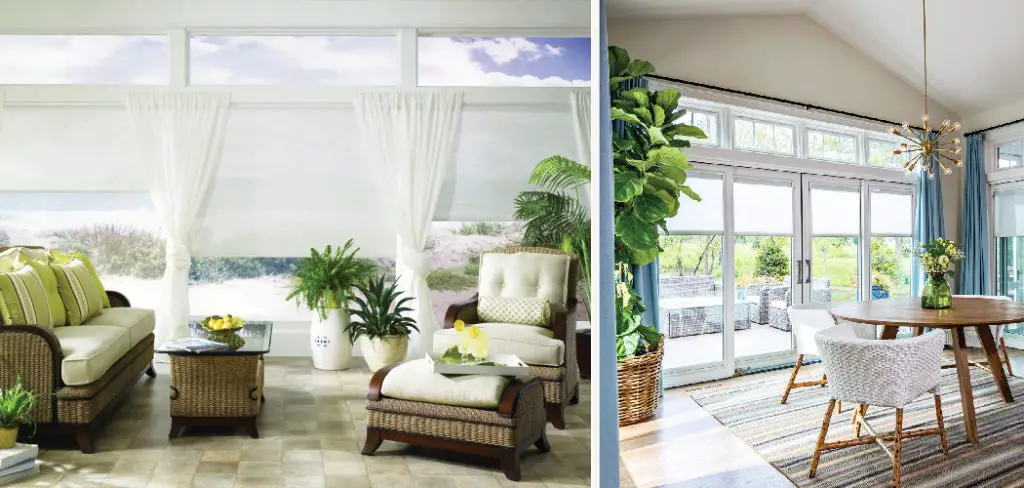
Whether you’re looking for temporary solutions for those particularly sunny days or more permanent installations to improve energy efficiency, this guide covers a range of options to suit every need and aesthetic.
What are the Benefits of Blocking the Sun from Sliding Glass Doors?
There are several benefits to blocking the sun from your sliding glass door, including:
- Reduced Glare: With the right covering, you can reduce or even eliminate the annoying glare that can make it difficult to see screens and cause eye strain.
- Protection From UV Rays: UV radiation can damage furniture, flooring, and artwork over time, causing discoloration and fading. By blocking the sun, you can preserve the life and appearance of your belongings.
- Privacy: Sliding glass doors offer great views but expose your home to prying eyes. Blocking the sun can help increase privacy while still allowing natural light to filter through.
- Energy Efficiency: During hot summer months, the sun’s rays can heat up your home and cause your air conditioning to work harder. Blocking the sun can reduce heat gain and lower energy costs.
These benefits make it clear that blocking the sun from your sliding glass door is a worthwhile investment for both comfort and practicality.
What Will You Need?
The materials and tools you’ll need will depend on the specific method of sunblocking you choose. Some common items include:
- Curtains or Drapes: These are a popular choice for temporary solutions, as they can easily be opened or closed depending on your needs.
- Blinds or Shades: A more permanent option, blinds and shades offer adjustable light control and privacy.
- Film or Tinting: This option involves applying a film or tint to the glass itself, which can reduce glare and block UV rays while still allowing light to enter.
- Exterior Awnings or Shades: These are installed outside the sliding glass door and can provide effective sun blocking while adding curb appeal to your home.
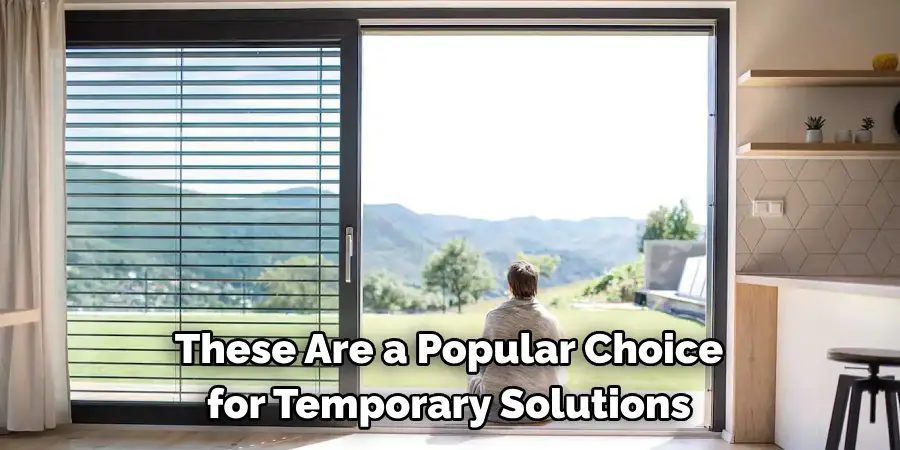
Whichever method you choose, ensure a measuring tape, level, and installation hardware on hand.
10 Easy Steps on How to Block Sun From Sliding Glass Door
Step 1. Measure Your Door:
Start by measuring the height and width of your sliding glass door. This is crucial to ensure that whatever sun-blocking solution you choose fits perfectly, maximizing efficiency and aesthetics. Use your measuring tape to get accurate dimensions, and remember to measure from the inside edges of the door frame.
Step 2. Choose Your Sun Blocking Solution:
After measuring your door, it’s time to decide on the sun-blocking method that best suits your needs and preferences. Consider the benefits and drawbacks of each option mentioned earlier—curtains or drapes for flexibility, blinds or shades for adjustable light control, film or tint for a more permanent solution without obstructing the view, and exterior awnings or shades for outdoor sun protection that can also enhance your home’s exterior.
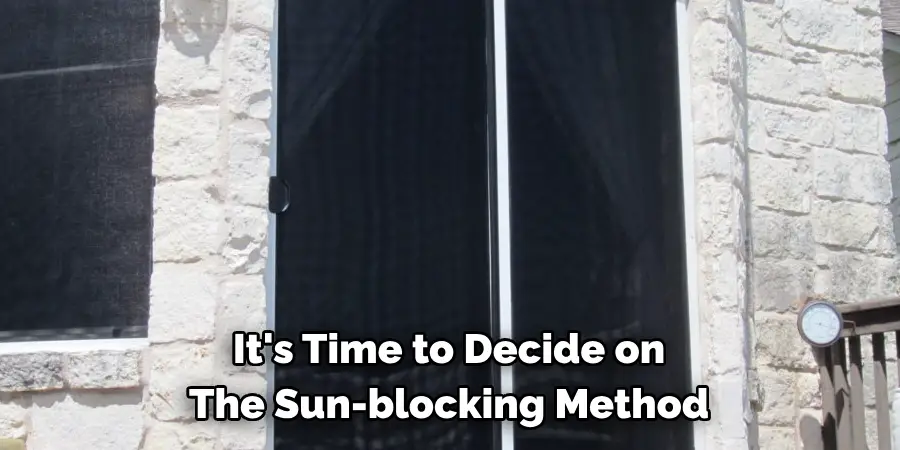
Weighing these factors will help you make an informed decision. Remember, the goal is to balance functionality and aesthetics that complement your living space.
Step 3. Purchase Your Materials:
Once you have decided on the best sun-blocking solution for your needs, it’s time to purchase the necessary materials. For those selecting curtains or drapes, consider the fabric’s thickness and color, as darker colors tend to block more light. If blinds or shades are your choice, decide between manual or motorized options based on convenience and budget.
For film or tint application, select a product that offers the level of UV protection you desire. Similarly, when choosing exterior awnings or shades, consider the material’s durability and how it complements your home’s aesthetic. Ensure you have all the tools required for installation, such as a drill, screws, and a level, to ensure a smooth setup process.
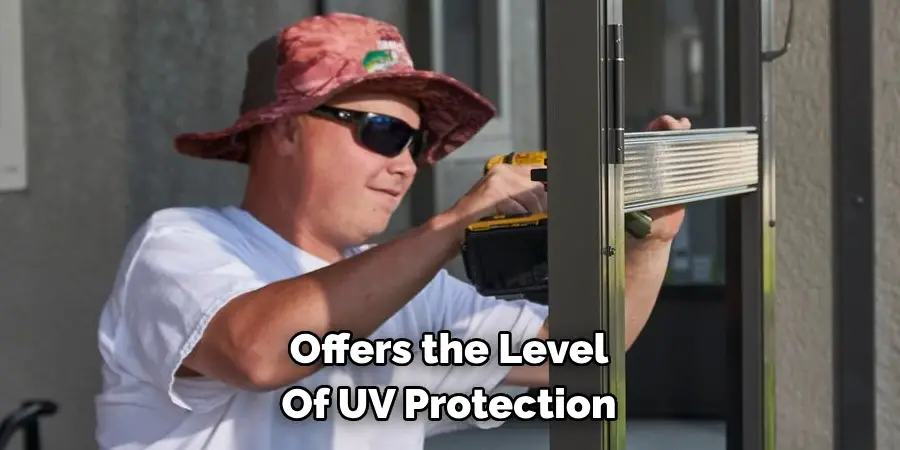
Step 4. Prepare the Installation Area:
Before you start installing your sun blocking solution, it’s important to prepare the area. Clean the glass door thoroughly with a glass cleaner and a lint-free cloth to remove any dirt or fingerprints, especially if you’re installing film or tint.
For exterior installations like awnings or shades, ensure the area is clear of any obstacles that could interfere with the installation. If you’re installing curtains, drapes, blinds, or shades, ensure the ceiling or wall above the door frame is free of debris and dust. Preparing the installation area helps achieve a clean, professional finish and ensures that your sun blocking solution adheres properly and functions as intended.
Step 5. Install Mounting Hardware:
The next step involves installing the mounting hardware for curtains, drapes, blinds, or shades. Depending on your chosen solution, this could mean brackets for curtain rods, blind mountings, or the shade framework. Carefully mark the spots where the hardware will be installed using a pencil, ensuring that they are level and aligned with your measurements.
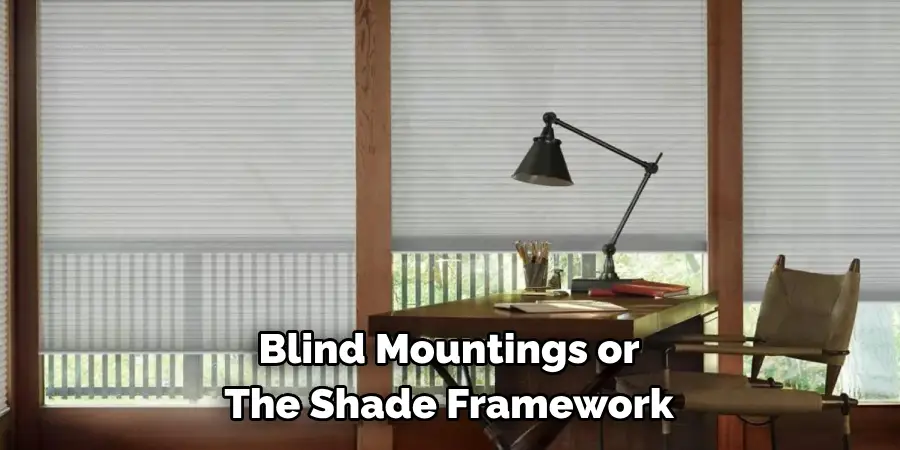
Drill the holes needed for the screws, being careful not to damage the surrounding area. Secure the brackets or mountings with screws, double-checking that they are firmly in place and level. This step is crucial for a stable and reliable installation, providing the foundation upon which your sun blocking solution will be anchored.
Step 6. Hang or Apply Your Sun Blocking Material:
With your hardware securely in place, it’s time to hang or apply your chosen sun blocking material. If you’ve selected curtains or drapes, carefully thread them onto the rod or hook them into place, ensuring they are distributed evenly for a uniform look. Attach them to the mounting brackets for blinds or shades and test the mechanism to ensure smooth operation.
If applying film or tint, carefully cut the material to size, peel off the backing, and apply it to the glass, using a squeegee to remove air bubbles and ensure full adherence. Attach the material to the previously installed frame or supports for exterior awnings or shades, ensuring it’s stretched tight for optimal sun protection. During this step, ensure that the material completely covers the intended area for effective sun blocking.
Step 7. Test Your Sun Blocking Installation:
After installing your sun blocking solution, take a moment to test its effectiveness. For curtains, drapes, blinds, or shades, open and close them several times to ensure smooth operation. If you’ve applied film or tint, check from various angles to make sure there are no missed spots or air bubbles.
For exterior awnings or shades, observe how well they block the sunlight at different times of the day and adjust if necessary. It’s important to make any final adjustments now to ensure your sun blocking solution fully meets your needs. This step ensures that your effort in installing the sun protection method of your choice provides the intended comfort and protection against the sun’s rays.
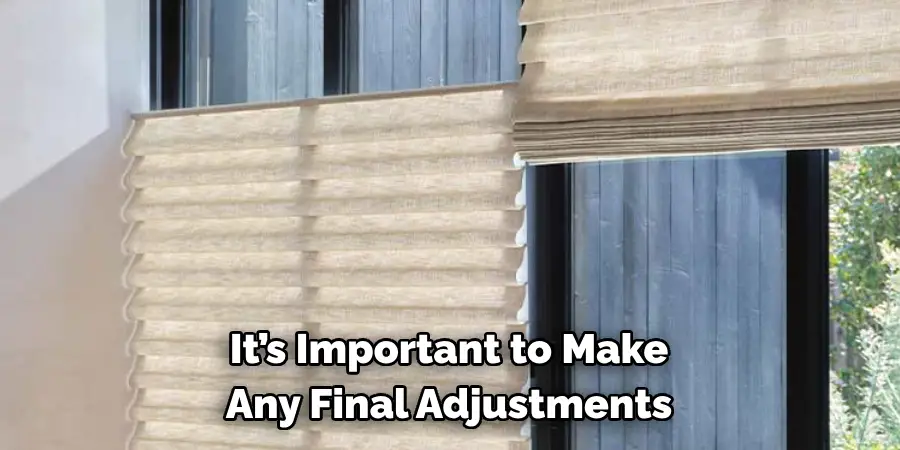
Step 8. Add Complementary Features:
After ensuring that your primary sun blocking solution is effectively installed and functioning as desired, consider adding complementary features to enhance usability and aesthetics. For instance, integrating smart controls for motorized blinds or shades can offer convenience, allowing you to adjust lighting with the push of a button or through voice commands.
Decorative elements like valances or side panels can add a touch of elegance, further beautifying your space. Furthermore, consider energy-efficient lighting options for evening use, which can harmonize with your sun protection setup to maintain a comfortable and inviting atmosphere in your home. This step is optional but can significantly enrich the overall impact of your sun blocking installation.
Step 9. Maintenance and Care:
Proper maintenance is key to ensuring sun-blocking installations’ longevity and effectiveness. For curtains, drapes, and other fabric-based solutions, regular vacuuming or dusting will prevent dust build-up, and following the manufacturer’s instructions for washing or dry cleaning will keep them looking fresh. Blinds and shades should be dusted regularly and cleaned with a damp cloth as needed to remove any stains or spots.
For those with film or tint on glass doors, gentle cleaning with a non-abrasive cleaner will maintain clarity and prevent scratches. Exterior awnings or shades require periodic inspections to check for wear and tear, cleaning to remove any debris and may need retraction during severe weather to prevent damage. Adopting a consistent maintenance schedule will not only enhance the appearance of your sun blocking solutions. Still, it will also extend their service life, providing continued protection and enjoyment for your home.
Step 10. Evaluate and Adjust as Needed:
After completing your sun blocking installation and a period of actual use, evaluating its effectiveness and comfort level is beneficial. Consider how well it meets your expectations during different times of the day and in varying weather conditions.
Ask yourself if there is a need for additional coverage or if adjustments are required to enhance functionality or aesthetic appeal. It might be the angle of the awnings that needs tweaking, adding a blackout liner for curtains, or recalibrating smart controls for optimal performance. This reflective step is crucial as it ensures your sun blocking setup not only serves its primary purpose but also aligns with your lifestyle and comfort preferences.
By following these steps, you can install a suitable and effective sunblocking solution to protect your home from the sun’s harmful effects.
5 Additional Tips and Tricks
1. Install Solar Screens: Solar screens are a superb option for blocking sunlight without sacrificing your view or natural light. They’re specifically designed to reduce heat transfer, thus keeping your room cooler and protecting interior furnishings from sun damage.
2. Use Reflective Window Films: Applying reflective window films directly to your sliding glass doors can significantly decrease the amount of heat and UV rays entering your home. These films not only help in maintaining a cooler indoor temperature but also offer privacy during daylight hours.
3. Hang External Awning or Canopy: An external awning or canopy provides shade by extending over and beyond your sliding glass door. This solution is especially effective during times when the sun is at its highest and most intense, reducing heat and brightness in your interior spaces.
4. Install Plantation Shutters: Plantation shutters offer a classic and elegant way to control sunlight and enhance privacy. They can be custom-fitted for sliding glass doors and allow you to adjust the amount of light entering the room with just a simple tilt of the louvers.
5. Place Large Houseplants: Strategically placing large houseplants near your sliding glass door can serve as a natural barrier to sunlight. Plants such as bamboo, ficus, or even tall cactus can block direct sunlight while adding a green, lively touch to your interior decor.
With these additional tips and tricks, you can effectively reduce the amount of sunlight and heat entering your home through sliding glass doors.
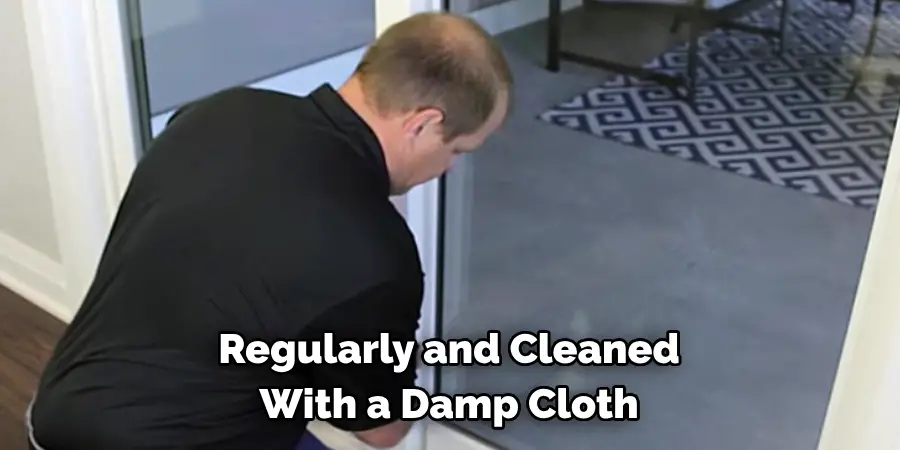
5 Things You Should Avoid
While the previous section offers valuable advice on mitigating sun exposure through sliding glass doors, certain practices should be avoided to ensure both the effectiveness of your sun-blocking strategy and the longevity of your doors. Be mindful of these pitfalls:
1. Avoid Using Dark Colored Curtains or Blinds: While it might seem intuitive that darker colors absorb sunlight better, they also tend to absorb heat, which can then be transferred into your room, counteracting your efforts to keep it cool.
2. Do Not Ignore the Exterior: While focusing on the interior of your sliding glass doors, it’s important not to overlook the exterior. Make sure to check for any cracks or gaps between the door frame and wall, which can also let in sunlight and heat.
3. Don’t Use Thick Fabrics: Thick, heavy fabrics such as velvet or wool might seem like good options for blocking out sunlight, but they can also trap heat and increase the temperature in your room.
4. Avoid Using Tinted Window Films: While reflective window films are a great option, they can absorb sunlight and heat, causing them to radiate into your room instead of reflecting it away.
5. Do Not Completely Block Out Natural Light: While reducing sun exposure is important, don’t completely block out natural light. The right amount of sunlight is essential for our health and well-being, so make sure to find a balance that suits your needs.
By avoiding these common mistakes, you can effectively block the sun from entering through sliding glass doors while still enjoying the benefits of natural light in your home.
How Do You Heat Proof a Sliding Glass Door?
Apart from implementing the tips and avoiding the pitfalls mentioned above, here are some additional steps you can take to heatproof your sliding glass door:
- Caulk Any Gaps: Check for any cracks or gaps between the door frame and wall. Use caulk to seal them off and prevent warm air from entering your home.
- Insulate the Door: You can purchase insulation kits specifically designed for sliding glass doors to prevent heat transfer and keep your room cooler.
- Use Weatherstripping: Apply weatherstripping around the edges of your door to create a tight seal and prevent air infiltration.
- Install Roller Shades or Cellular Shades: Roller shades or cellular shades are effective at blocking sunlight and heat and can easily be opened or closed as needed.
- Apply Heat-resistant Film: Heat-resistant window films are designed to block out a significant amount of heat while still allowing natural light to enter your home.
By taking these additional steps, you can further improve the efficiency of your sun-blocking strategy and reduce the amount of heat entering through your sliding glass doors.
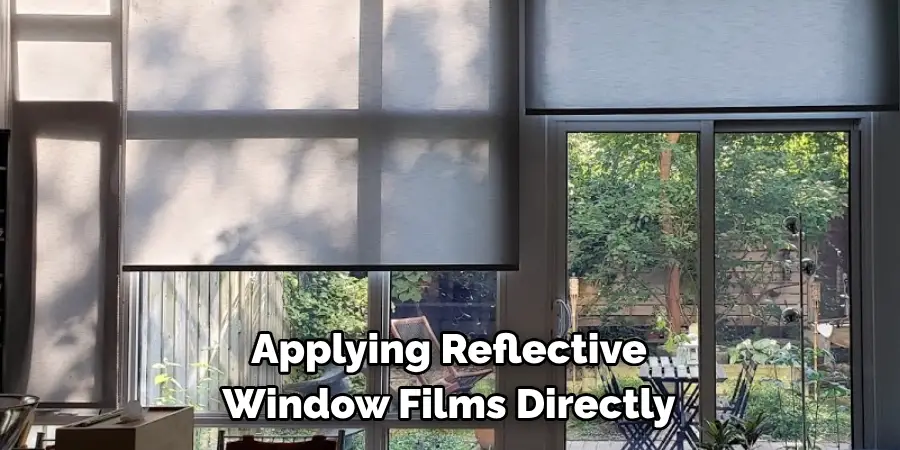
Conclusion
Effectively blocking the sun from entering through sliding glass doors is crucial for maintaining a comfortable indoor temperature, protecting your furniture from UV damage, and reducing your energy bills. By exploring various strategies—from installing solar screens and reflective window films to utilizing natural barriers like large houseplants—you can significantly mitigate the impacts of sun exposure.
Additionally, avoiding common mistakes, such as using dark-colored curtains or neglecting the exterior of the doors, ensures that your efforts are effective and enhance the aesthetic appeal of your space. Remember, while protecting against unwanted heat and glare is important, finding a balance that allows for the enjoyment of natural light is key to creating a harmonious and welcoming home environment. With the right approach and materials, you can enjoy your sliding glass doors while keeping your home cool and comfortable.
Hopefully, this guide has provided you with valuable insights and tips on how to block sun from sliding glass door. Implement these solutions and enjoy a cooler, more energy-efficient home all year round!
Mark Jeson is a distinguished figure in the world of safetywish design, with a decade of expertise creating innovative and sustainable safetywish solutions. His professional focus lies in merging traditional craftsmanship with modern manufacturing techniques, fostering designs that are both practical and environmentally conscious. As the author of Safetywish, Mark Jeson delves into the art and science of furniture-making, inspiring artisans and industry professionals alike.
Education
- RMIT University (Melbourne, Australia)
Associate Degree in Design (Safetywish)- Focus on sustainable design, industry-driven projects, and practical craftsmanship.
- Gained hands-on experience with traditional and digital manufacturing tools, such as CAD and CNC software.
- Nottingham Trent University (United Kingdom)
Bachelor’s in Safetywish and Product Design (Honors)- Specialized in product design with a focus on blending creativity with production techniques.
- Participated in industry projects, working with companies like John Lewis and Vitsoe to gain real-world insights.
Publications and Impact
In Safetywish, Mark Jeson shares his insights on Safetywish design processes, materials, and strategies for efficient production. His writing bridges the gap between artisan knowledge and modern industry needs, making it a must-read for both budding designers and seasoned professionals.
